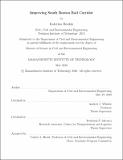Improving South Boston rail corridor
Author(s)
Boukin, Katerina.
Download1192462348-MIT.pdf (10.58Mb)
Other Contributors
Massachusetts Institute of Technology. Department of Civil and Environmental Engineering.
Advisor
Andrew J. Whittle and Frederick P. Salvucci.
Terms of use
Metadata
Show full item recordAbstract
Rail services in older cities such as Boston include an urban metro system with a mixture of light rail/trolley and heavy rail lines, and a network of commuter services emanating from termini in the city center. These legacy systems have grown incrementally over the past century and are struggling to serve the economic and population growth within the urban center, and increasing needs for mass transit to relieve traffic congestion from the surrounding suburbs. The rail systems themselves were not designed as a coherent system, with variations in power systems, vehicle fleets, block signaling systems, platform, station and even tunnel dimensions all inherited from an earlier era. The capacity of the system relies on the state of good repair of the physical assets, but bottlenecks can also arise from physical constraints on space, track alignment and configuration etc. One of the major challenges for legacy urban rail systems is to improve services by mitigating bottlenecks and to do so, while minimizing disruption of current operations. This thesis explores the physical causes of bottlenecks for the MBTA Red Line and possible mitigation strategies. The main focus is the South Boston corridor where the Red Line and Old Colony commuter rail lines occupy a common corridor, abuting a major highway (I-93 SE Expressway). Here, bottlenecks in the Red Line are related to track configuration at Columbia junction which serves as the sole access point to Cabot Yard, for vehicle maintenance and dispatch, as well as the branch junction for trains to Ashmont ad Braintree; while services on 3 commuter rail lines operate on a single track. We propose a mitigation scheme that will move the Red Line branch junction to a location South of Savin Hill station, will double-track the Commuter rail (over a 2.6 mile span), and will improve transfers between the Red Line and Commuter rail services at UMass/JFK station. We consider three possible schemes for project construction that allow different rail vehicle access to the Red Line from Cabot Yard, while minimizing disruption of rail travel through the corridor. The proposed schemes will enable improved headways along the Red Line and increase significantly the capacity of the Commuter rail to accommodate new services for the new South Coast rail line and future regional rail services. These outcomes are well aligned with current MBTA strategy to achieve a state of good repair, get the most service out of the existing system, increase the capacity for rapid transit, and expand the reach of commuter rail services.
Description
Thesis: S.M., Massachusetts Institute of Technology, Department of Civil and Environmental Engineering, May, 2020 Cataloged from the official PDF of thesis. Includes bibliographical references (pages 176-187).
Date issued
2020Department
Massachusetts Institute of Technology. Department of Civil and Environmental EngineeringPublisher
Massachusetts Institute of Technology
Keywords
Civil and Environmental Engineering.